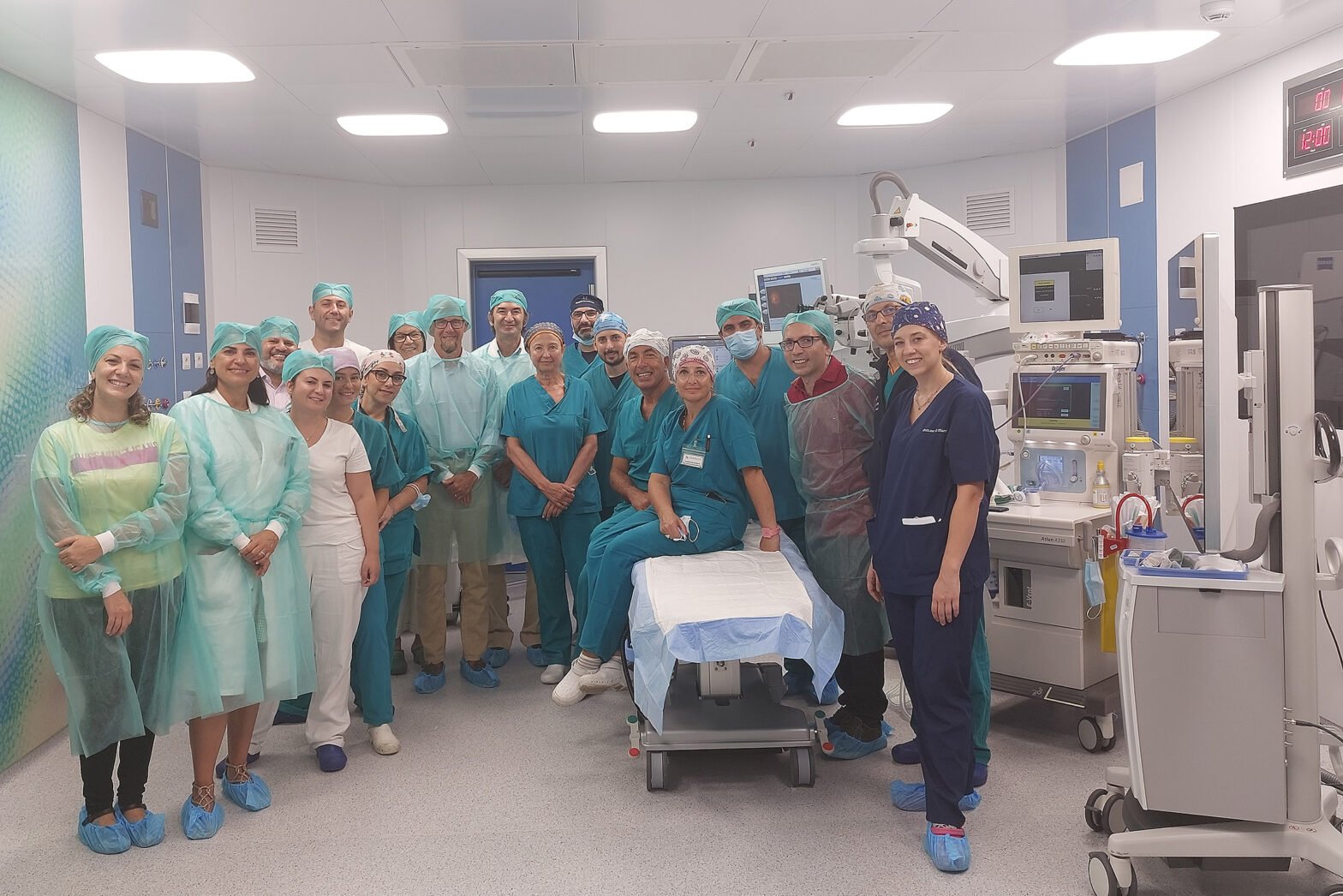The surgery, performed at AOU Vanvitelli, was made possible by an innovative gene therapy platform developed by Pozzuoli’s TIGEM that allows for large gene transfer.

For the first time in the world, an experimental gene therapy for Usher syndrome type 1B, rare hereditary eye disease associated with deafness, was administered at the Ophthalmology Clinic of the University of Campania “Luigi Vanvitelli” in Naples. This innovative technology used, developed in the laboratories of the Telethon Institute of Genetics and Medicine (Tigem) in Pozzuoli, has the potential to extend this therapeutic approach to hundreds of other currently incurable genetic diseases. The study, named LUCE-1, is sponsored by AAVantgarde Bio, a biotechnology company established in 2021 as a Tigem spin-off.
Gene therapy is now a therapeutic reality for several diseases, genetic and otherwise. However, its application is still mited by certain obstacles. One such obstacle is the capacity of viral vectors – modified viruses used to transfer corrected versions of genes into patients’ cells. This issue is exemplified in the case of Usher syndrome type 1B, a hereditary disease that affects the retina and inner ear, impacting an estimated 20,000 people in the United States and the European Union. Children with this condition are born deaf, experience vestibular dysfunction, and begin to progressively lose vision within the first decade of life. While surgical treatments exist to address deafness, there are currently no treatments to prevent progress.
The syndrome is due to mutations in a gene, MYO7A, which is too large to fit into the vectors most commonly used to correct genetic defects of the eye. These vectors are derived from small viruses in the adeno-associated virus (AAV) family. For this syndrome, as well as for more than a hundred genetic diseases due to genes too large to be “packaged” in current vectors, gene therapy was precluded to date. At the TIGEM Institute in Pozzuoli, newly appointed director Alberto Auricchio, who is also a full professor of Medical Genetics at the University “Federico II” of Naples, has been working for many years to overcome this technical limitation. With the support of Fondazione Telethon and major international funding, he and his team developed two different platforms that enable the transfer of large “fragmented” genes, ensuring that once inside the cell the full therapeutic protein is correctly produced.
AAVantgarde Bio, co-founded by Alberto Auricchio, has acquired the exclusive license for hereditary retinal diseases for both platforms. The platform applied here is called “dual-AAV” and involves two AAV-like vectors, each containing one half of the genetic information needed to produce the therapeutic protein. Once inside the cell, these halves recombine, allowing the production of the protein in sufficient quantities.
The world’s first treatment in a patient with USH1B syndrome was carried out at the Ophthalmology Clinic of the University of Campania “Luigi Vanvitelli” by the team headed by Francesca Simonelli, full professor of Ophthalmology and director of the Ophthalmology UOC, who is among the top international experts in ocular gene therapy. The Naples Ophthalmology Clinic is among the three centers selected in Europe, and Francesca Simonelli is the study leader. The procedure involves injection of the vector into the sub-retinal space in the eye under general anesthesia. The objective of the phase 1/2 LUCE-1 study is to evaluate the safety and tolerability of this gene therapy in people with Usher syndrome type 1B-related retinitis pigmentosa.
“It is very exciting that our dual-AAV technology is being tested in humans for an ophthalmic indication. It now embarks on a new journey where we hope that the positive results observed in the laboratory will be confirmed in patients. Our ultimate goal is to help patients have visual function,” commented Alberto Auricchio.
“I am pleased to have initiated the first phase 1/2 human clinical trial of AAV-081 for patients with Usher 1B syndrome-related retinitis pigmentosa,” said Francesca Simonelli. “Through this innovative program, in which we have been engaged for many years, we aim to revolutionize our approach to understanding and treating these patients for whom no therapy exists. We are poised to generate robust evidence that will not only advance scientific knowledge, but also directly impact the care of these people.”
“I am particularly pleased that the University of Campania has been involved in this futuristic pilot project,” added Rector Gianfranco Nicoletti. “Our Eye Clinic, directed by Professor Simonelli, has been selected at the European level as a reference center for ocular gene therapy. I believe that scientific research serves the community and, enabling the treatment and cure even of rare diseases, such as Usher syndrome, significantly improving the quality of life of our young patients. I therefore thank all of Professor Simonelli’s team whose professionalism and dedication, have made this important goal possible.”
“The creativity and scientific value of the “Federico II” University professors and researchers who have been working at Tigem for years find further confirmation in this result. It not only allows the transfer of technology developed in biotechnology laboratories to the patient’s bedside of a, but also offers numerous opportunities for treating severe diseases using a gene therapy capable of intervening on large genes, overcoming a significant technical limitation,” commented the Rector of the University ‘Federico II’ Matteo Lorito. “The work of Prof. Auricchio and his team, as well as that of all Tigem staff involved, has enabled clinicians to test a new therapeutic approach for a rare but extremely disabling disease. Our investment in human resources-recruitment of professors, researchers, doctoral students, postdoctoral fellows-in favor of Tigem and its advanced research projects- continues to bear fruit, and contributes to increasing the already high international relevance of our scientists at Tigem and the university departments to which they belong.”
